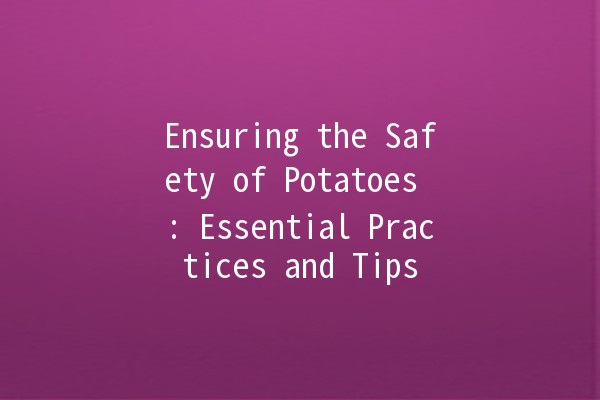Potatoes are a staple food around the world, celebrated for their versatility, taste, and nutritional value. However, ensuring their safety from farm to fork is paramount for public health. This article delves into the safety assurances associated with potato consumption, exploring various aspects including cultivation, storage, preparation, and cooking. By understanding the potential risks and applying some practical tips, you can enjoy potatoes without worry. Let’s explore this vital topic indepth.
Understanding Potato Safety
The safety of potatoes begins with their cultivation. Farmers follow strict guidelines regarding pesticide use, soil health, and water quality. Many regions have regulations to ensure that the growing process minimizes the risk of contamination.
Application Example: Engage with local farmers or buy organic potatoes, which are often grown with fewer pesticides and additives, ensuring a safer product.
Once harvested, handling practices play a crucial role in maintaining the safety of potatoes. Improper handling can lead to physical damage and can promote the growth of harmful bacteria.
Tips for Safe Handling:
Always wash hands before handling food.

Use clean tools and surfaces to prepare potatoes.
Avoid crosscontamination by keeping raw potatoes separate from other foods.
Incorrect storage can compromise not only the quality but also the safety of potatoes. Different storage conditions can affect the development of solanine, a natural toxin present in green or sprouted potatoes.
Storage Guidelines:
Keep potatoes in a cool, dark place to prevent greening and sprouting.
Ideal temperatures are around 45°F to 50°F (7°C to 10°C).
Avoid storing potatoes in the refrigerator, as colder temperatures can convert their starches to sugars, altering their taste and texture.
Safety Risks Associated with Potatoes
Identifying the potential risks is essential for ensuring safe consumption:
Solanine is a glycoalkaloid found in potatoes, particularly in green or damaged areas. Consuming large amounts can lead to symptoms like nausea, headache, and in severe cases, even neurological issues.
Practical Tip: Always cut away any green areas or sprouts before cooking. If a potato is extensively green, it’s best to discard it.
Potatoes can harbor harmful bacteria such as Salmonella and E. coli, particularly if they are improperly washed or cooked.
Prevention Strategies:
Rinse potatoes thoroughly under running water to remove dirt and bacteria.
Scrub the surface of potatoes with a clean brush, especially those with a thicker skin.
Cooking Potatoes Safely
Proper cooking is critical to eliminate any pathogenic bacteria and toxins:
Different methods of cooking can impact the safety and flavor of potatoes. Boiling, baking, and frying are popular methods, but each requires careful attention.
Cooking Recommendations:
Always ensure that potatoes are cooked thoroughly, reaching an internal temperature of at least 165°F (74°C).
Avoid cooking potatoes that have visible green spots or sprouts as heat may not eliminate solanine effectively.
While reheating leftovers, particularly those containing potatoes, proper methods should be observed to avoid foodborne illnesses:
Reheat potatoes to an internal temperature of 165°F (74°C) to ensure they're safe to eat.
Consume leftovers within three to five days, and store them correctly in the refrigerator.
Quick Tips for Potato Preparation
Frequently Asked Questions
Organic potatoes are generally grown without synthetic pesticides and fertilizers, which may reduce the risk of chemical contamination. However, safety also depends on proper handling, storage, and cooking practices, whether organic or not.
Signs of spoilage include significant sprouting, a strong odor, or extensive greening. If you notice any of these, it's best to discard the potato.
Yes, potato peels are nutritious and safe to eat when properly washed. Avoid consuming peels from green potatoes. Thoroughly cooking peels can also enhance safety.
Freezing fresh potatoes is not recommended as they can become grainy and change texture. If you wish to freeze potatoes, consider cooking them first.
Potatoes are an excellent source of vitamins, notably vitamin C, potassium, and dietary fiber. When prepared healthily (e.g., baked rather than fried), they can be a nutritious addition to meals.
Cooking does not effectively reduce the levels of solanine in green potatoes. Removing the green parts is essential before cooking, and extensively green potatoes should be discarded.
, ensuring the safety of potatoes involves a multifaceted approach, from responsible farming practices to proper handling, storage, and cooking techniques. By applying the above recommendations, you can enjoy this versatile vegetable while minimizing any potential risks. Remember, safety starts from understanding and employing best practices in every stage of potato preparation—from the farm to your plate.